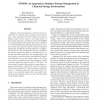102
Voted
CCGRID
2007
IEEE
15 years 24 days ago
2007
IEEE
Grid is a computational environment in which applications can use multiple distributed computational resources in a safe, coordinated, efficient and transparent way. Data Integra...
109
Voted
CCGRID
2007
IEEE
15 years 4 months ago
2007
IEEE
A computer-aided diagnostic (CAD) method of calculating lumen and wall thickness of carotid vessels is presented. The CAD is able to measure the geometry of the lumen and plaque s...
127
click to vote
CCGRID
2007
IEEE
15 years 4 months ago
2007
IEEE
We describe a hybrid linear programming (LP) and evolutionary algorithm (EA) based resource matcher suitable for heterogeneous grid environments. The hybrid matcher adopts the ite...
103
Voted
CCGRID
2007
IEEE
15 years 4 months ago
2007
IEEE
In this paper, we present a node mobility prediction framework based on a generic mobile grid architecture. We show how this framework can be used to formulate a cost effective job...
131
Voted
CCGRID
2007
IEEE
15 years 4 months ago
2007
IEEE
Database storage management in clustered storage environments is a manual, time-consuming, and error-prone task. Such management involves regular movement of database objects acro...
88
Voted
CCGRID
2007
IEEE
15 years 4 months ago
2007
IEEE
Computational grids are solutions for several biological applications like virtual screening or molecular dynamics where large amounts of computing power and storage are required....
104
Voted
CCGRID
2007
IEEE
15 years 7 months ago
2007
IEEE
One of the advantages in virtualized computing clusters compared to traditional shared HPC environments is their ability to accommodate user-specific system customization. Howeve...
106
Voted
CCGRID
2007
IEEE
15 years 7 months ago
2007
IEEE
Malleability enables a parallel application’s execution system to split or merge processes modifying granularity. While process migration is widely used to adapt applications to...
100
Voted
CCGRID
2007
IEEE
15 years 7 months ago
2007
IEEE
Typical computational grid users target only a single cluster and have to estimate the runtime of their jobs. Job schedulers prefer short-running jobs to maintain a high system ut...
120
click to vote
CCGRID
2007
IEEE
15 years 7 months ago
2007
IEEE
Abstract— Scientific computing is being increasingly deployed over volunteer-based distributed computing environments consisting of idle resources on donated user machines. A fu...





